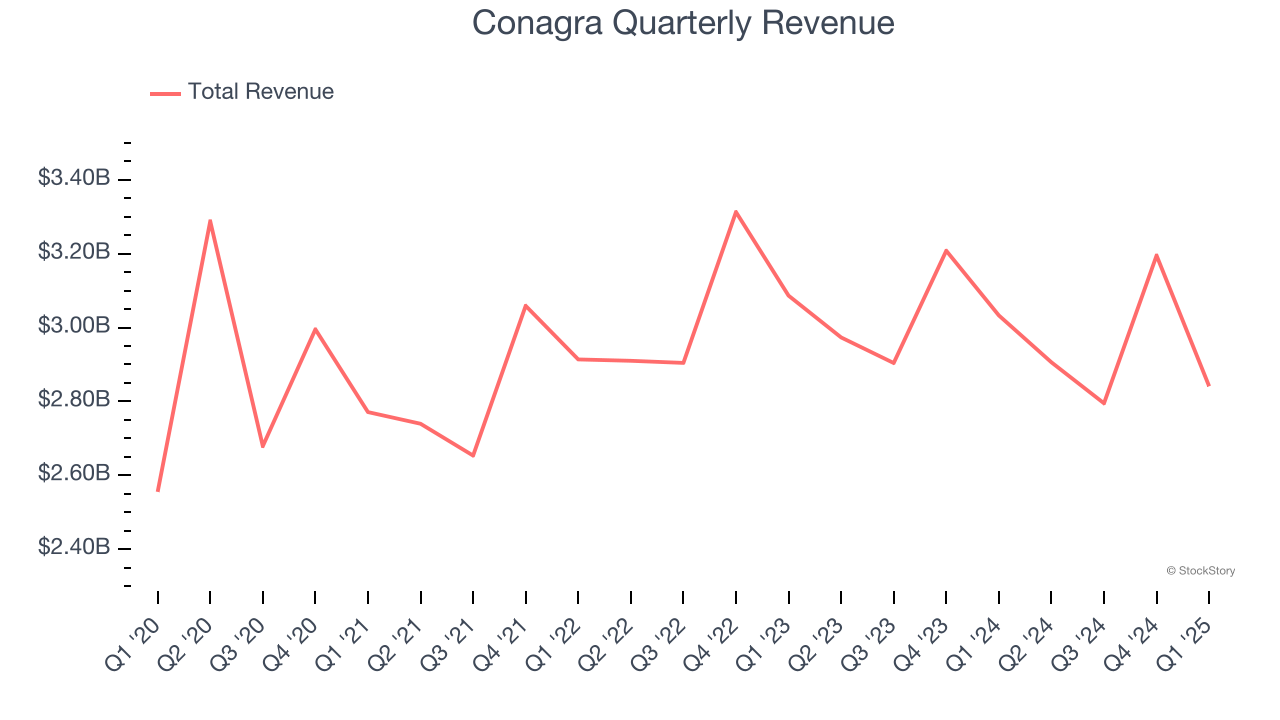
Packaged foods company Conagra Brands (NYSE:CAG) missed Wall Street’s revenue expectations in Q1 CY2025, with sales falling 6.3% year on year to $2.84 billion. Its non-GAAP profit of $0.51 per share was 3.3% below analysts’ consensus estimates.
Is now the time to buy Conagra? Find out by accessing our full research report, it’s free.
Conagra (CAG) Q1 CY2025 Highlights:
- Revenue: $2.84 billion vs analyst estimates of $2.9 billion (6.3% year-on-year decline, 2% miss)
- Adjusted EPS: $0.51 vs analyst expectations of $0.53 (3.3% miss)
- Adjusted EBITDA: $514 million vs analyst estimates of $495.1 million (18.1% margin, 3.8% beat)
- Management lowered its full-year Adjusted EPS guidance to $2.35 at the midpoint, a 5.1% decrease
- Operating Margin: 9.4%, down from 15.5% in the same quarter last year
- Free Cash Flow Margin: 17.7%, down from 19.2% in the same quarter last year
- Organic Revenue fell 5.2% year on year (-2% in the same quarter last year)
- Sales Volumes fell 3.1% year on year (-1.8% in the same quarter last year)
- Market Capitalization: $12.59 billion
Company Overview
Founded in 1919 as Nebraska Consolidated Mills in Omaha, Nebraska, Conagra Brands today (NYSE:CAG) boasts a diverse portfolio of packaged foods brands that includes everything from whipped cream to jarred pickles to frozen meals.
Shelf-Stable Food
As America industrialized and moved away from an agricultural economy, people faced more demands on their time. Packaged foods emerged as a solution offering convenience to the evolving American family, whether it be canned goods or snacks. Today, Americans seek brands that are high in quality, reliable, and reasonably priced. Furthermore, there's a growing emphasis on health-conscious and sustainable food options. Packaged food stocks are considered resilient investments. People always need to eat, so these companies can enjoy consistent demand as long as they stay on top of changing consumer preferences. The industry spans from multinational corporations to smaller specialized firms and is subject to food safety and labeling regulations.
Sales Growth
Reviewing a company’s long-term sales performance reveals insights into its quality. Any business can experience short-term success, but top-performing ones enjoy sustained growth for years.
With $11.74 billion in revenue over the past 12 months, Conagra is one of the larger consumer staples companies and benefits from a well-known brand that influences purchasing decisions. However, its scale is a double-edged sword because it’s harder to find incremental growth when your existing brands have penetrated most of the market. To accelerate sales, Conagra likely needs to optimize its pricing or lean into new products and international expansion.
As you can see below, Conagra grew its sales at a weak 1.1% compounded annual growth rate over the last three years as consumers bought less of its products. We’ll explore what this means in the "Volume Growth" section.

This quarter, Conagra missed Wall Street’s estimates and reported a rather uninspiring 6.3% year-on-year revenue decline, generating $2.84 billion of revenue.
Looking ahead, sell-side analysts expect revenue to remain flat over the next 12 months. This projection doesn't excite us and suggests its newer products will not lead to better top-line performance yet.
Unless you’ve been living under a rock, it should be obvious by now that generative AI is going to have a huge impact on how large corporations do business. While Nvidia and AMD are trading close to all-time highs, we prefer a lesser-known (but still profitable) stock benefiting from the rise of AI. Click here to access our free report one of our favorites growth stories.
Volume Growth
Revenue growth can be broken down into changes in price and volume (the number of units sold). While both are important, volume is the lifeblood of a successful staples business as there’s a ceiling to what consumers will pay for everyday goods; they can always trade down to non-branded products if the branded versions are too expensive.
To analyze whether Conagra generated its growth (or lack thereof) from changes in price or volume, we can compare its volume growth to its organic revenue growth, which excludes non-fundamental impacts on company financials like mergers and currency fluctuations.
Over the last two years, Conagra’s average quarterly volumes have shrunk by 1.2%. This isn’t ideal for a consumer staples company, where demand is typically stable. In the context of its 1.8% average organic sales declines, we can see that most of the company’s losses have come from fewer customers purchasing its products.

In Conagra’s Q1 2025, sales volumes dropped 3.1% year on year. This result represents a further deceleration from its historical levels, showing the business is struggling to move its products.
Key Takeaways from Conagra’s Q1 Results
We enjoyed seeing Conagra beat analysts’ EBITDA expectations this quarter. On the other hand, its gross margin missed and its organic revenue fell short of Wall Street’s estimates. Overall, this was a weaker quarter. The stock traded down 1.8% to $25.90 immediately following the results.
Conagra didn’t show it’s best hand this quarter, but does that create an opportunity to buy the stock right now? If you’re making that decision, you should consider the bigger picture of valuation, business qualities, as well as the latest earnings. We cover that in our actionable full research report which you can read here, it’s free.
